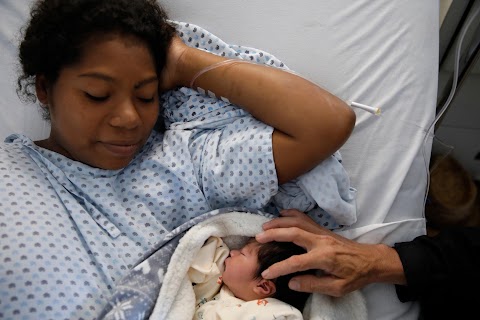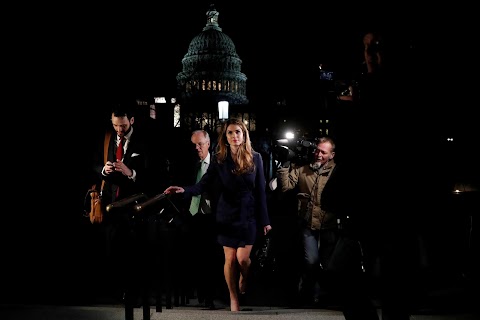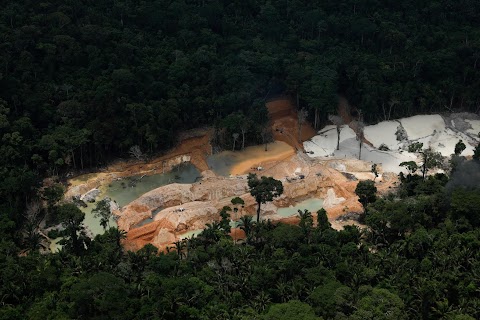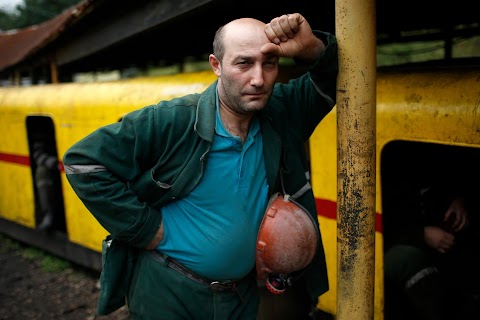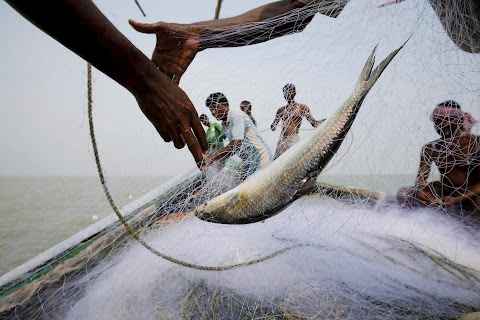
Caravans: the new face of migration, with no end in sight
A 5-year-old boy rests by the roadside with his mother as thousands of fellow migrants trudge past. A woman grips her two young daughters as they flee a cloud of tear gas. A child slithers under a fence to reach U.S. soil. A man sobs in a U.S. border patrol vehicle as his dreams of a new life are dashed.

These are the faces of migrants whose trek from Central America to the United States has transfixed the continent since mid-October.
As they drew closer to the U.S. border with Mexico, the thousands of mostly Honduran migrants became a symbol of U.S. President Donald Trump's tough policies on immigration.

For both the United States and Mexico, the caravan has raised hard questions about how to respond to a seemingly unending procession of migrants who say gang violence has made their countries unlivable.

The journey, made partly on foot, is punishing. And for those who reach the Mexican border city of Tijuana, the way forward is uncertain. U.S. officials have implemented a system of "metering," which limits how many can seek asylum in Tijuana.
Some migrants scramble over the border to avoid a months-long wait, handing themselves in to authorities in the hope they will be released.
The caravan has also created an early test for new Mexican President Andres Manuel Lopez Obrador as he tries to establish a relationship with the Trump administration.

Mexico, once the prime source of migration to the United States, now has to manage the rising flow of Central American families heading north to its own border. Lopez Obrador, who took office this month, is still weighing a U.S. proposal that would make asylum seekers wait in Mexico as their claims are decided, a process that can take years.

The caravan came on the heels of another group this spring, and it is not likely to be the last. For migrants with few options, traveling in large groups is safer than making the trip alone or paying an illegal people smuggler, known as a "coyote."
Slideshow

Adrees Latif: "One could hardly tell there were people lying in the brush even as a U.S. Border Patrol agent stood over these migrants. They were tracked into the brush by their shoe prints. The group of nine had taken cover overnight and were apprehended the following morning for illegally crossing into the U.S. from Mexico."

Adrees Latif: "U.S. Border Patrol agents tracked the shoe prints of nine migrants from Central America and Mexico into dense brush along the U.S. Mexican border. When agents encountered the group, most of them were asleep after travelling overnight. As the migrants came out of the brush, I noticed a young boy. His face was full of mosquito bites. The mood became somber as the boy started weeping. His wails echoed through the forest behind us. I would later find out the man he was embracing was his uncle and because he was not a parent, the two soon would be separated. As a parent of young children, this moment in particular has been heart wrenching and leaves me still wondering about the fate of this young boy and his family."

Adrees Latif: "Little happened after a full day ride along with the Border Patrol from the El Paso sector on June 15, 2018. As we were returning to sector headquarters, a call came in that three men had illegally crossed into the U.S. from Mexico in Sunland Park, New Mexico. As we arrived to where the men were seen last, so did agents on horseback. I followed them on foot as long as I could and photographed them while they tracked the men along the Rio Grande river. About an half hour later, the agents apprehended the men under a bridge about one mile away."

Mike Blake: "It was a lot of teamwork that made this picture happen, from finding the location to hunting down an aircraft for aerials while I flew into Texas on a commercial flight. The Trump administration's new policy of separating migrant children from their parents at the border had begun, but no one really understood until these images were transmitted out to the world the scale and reality of what was going on. After factoring in flight time to the camp, I asked the pilot to wait on the ground for an hour, thinking there was more likely to be movement around dinner time, the light being better then as well. This image was shot with a 600mm lens from 1,000 feet out the window of a small plane as we circled near the little town of Tornillo, Texas on the U.S.-Mexican border. The flight was hot and bumpy and the turbulence made it extremely difficult to even frame the image in the viewfinder. Reuters was the first to show such aerial images of the camp and, in the next morning when both the New York Times and Washington Post fronted their print editions with what I had photographed, President Trump signed an order ending the separation policy."

Leah Millis: "This photograph was taken while was following First Lady Melania Trump as she toured detention facilities run by U.S. Customs and Border Patrol, like this one. There were minors in this facility, but the very young children we saw (like the one pictured here) were with their mothers."

Border Patrol Agent Jacob Stukenberg looks at Guatemalan migrant Misael Paiz, 25, who died in the Sonoran Desert after traveling over 2,000 miles to cross the U.S.-Mexico border, on the Buenos Aires National Wildlife Refuge in Pima County, Arizona, U.S. Paiz was accompanied from his hometown of Aguacate, Guatemala, by his relative Joselino Gomez Esteban. Gomez Esteban called 911 after Paiz collapsed but Border Patrol agents were unable to locate Paiz before he died. Paiz died of hyperthermia or heatstroke just 3.3 miles from the border.

A rooster walks past the dead body of an Barrio-18 gang member in San Pedro Sula, Honduras.

Adrees Latif: "After covering immigration for months in the Rio Grande Valley, I was finally able to pinpoint locations where family units were crossing the Rio Grande river into the U.S. illegally from Mexico. On this particular day, I witnessed migrants using a raft to cross the river as others waited on the Mexican side for their turn. When this group started to exit the raft, I was stunned to see a five month old baby, as her mother holding a bottle of milk, came ashore. The group, who were seeking asylum, were soon apprehended and taken into custody."

Ueslei Marcelino: "The migrants had already broken through the first police barricade on the Guatemalan side of the bridge. After a while, they moved towards the second barricade on the Mexican side. The push by the migrants to enter Mexico had eased and suddenly women and children formed a line and started to walk towards the police. There was a bit of pushing and shoving, and then things started to get increasingly chaotic. It was a march that turned into a protest and ended up in confusion. Of course, it affected me. I'm also a father of a nine-year-old girl. It was impossible not to think about being that father caught up in that panicked situation. After taking the photo, I took others of families coming out of the restrictive cordon created by police. The confusion was brought under control after gas was used to disperse them, and the migrants were pushed back to the Guatemalan side."

Ueslei Marcelino: "While most of the migrants expected that there would be an agreement so that everyone could enter Mexico, we noticed that a few risked climbing down or jumping off the bridge linking the cities of Tecun Uman in Guatemala with Ciudad Hidalgo in Mexico."

Edgard Garrido: "A small Honduran child cried as the oppressive heat, uproar from the surrounding crowd and hours of waiting with his mother to enter Mexico legally became too much to bear. The image conveys the plight faced by many families traveling with children in tow, where fatigue, uncertainty, and the elements have an added level of drama. After traveling to the Mexico-Guatemala border, many of the migrants then had to wait three or four days on the bridge for Mexican authorities to let them cross the border. The wait is long and tedious, but hours after this picture was taken, the wailing child and mother were both let into Mexico. This scene, and others like it, hit home. A lack of opportunities, endemic violence and poverty prompted these families to abandon their homeland and embark on this arduous journey. The challenge in taking these pictures is getting to know the people, documenting this incredibly transcendental moment in their lives and conveying their humanity as truthfully as possible. I have been covering migrants since 2006 and followed this particular caravan of migrants for two weeks as they traveled through Guatemala to the Mexican border. As a photographer you have to make sure you put yourself in the right place and have the right light. Sometimes that is more obvious than others. In chaotic situations like this in the midst of hundreds of people, my experience and intuition guide me. I go searching for the light and underneath it inevitably there will be incredible moments to photograph."

Ueslei Marcelino: "With a journey of thousands of kilometers the migrants hitchhiked on trucks as much as they could. I decided to climb one of these trucks to accompany a group of Hondurans as they continued their journey. Here, one truck full of migrants, drives past another. People greeted one another by throwing water as a way of celebrating their luck at catching a ride."

Adrees Latif: "I photographed this migrant woman as she cleaned her daughter with a wet cloth in the centre of Huixtla. Throughout coverage of the migrant caravan I repeatedly noticed how at peace and content, even through the hardship and struggle, many of the families and children were. This moment reminded me of the special bond between a mother and child and I tried to photograph it in a way which would convey those feelings to the audience."

Ueslei Marcelino: "The migrants wake up very early to travel as far as possible during dawn and avoid walking in the heat of the day. For us photographers, the challenge was to overcome the technical difficulties of shooting in low light, so we had to take advantage of the light of a car headlight, the light emitted by a cell phone, or even the coloured light of the police cars as they illuminated the scene."

Police line up for a temporary blockade of a caravan of thousands of migrants from Central America, en route to the United States, making its way to San Pedro Tapanatepec from Arriaga, Mexico.

Adrees Latif: "I first noticed Israel and Estelle being affectionate while taking photos of migrants bathing and cleaning their cloths. I asked the couple if I could photograph them, they asked who I was working for and where these images would be published. As I did my best to explain in Spanish, they started kissing again. I took this image, asked their names, confirmed they were part of the caravan and left. As day turned into dusk and I started to make my way to the main road, I noticed they were still in the river, kissing."

Carlos Garcia Rawlins: "This picture of men trying to pull down the Mexican border gate seems to symbolise the struggle at the heart of this story: the tension between the urge to find a better life and governments' attempts to control borders. Hundreds of migrants had gathered at dawn on the bridge that marks the border between Guatemala and Mexico. They hoped the guards would open the gates and let them pass through as they moved towards the United States. But the gates stayed locked and as the day wore on tensions rose and tempers frayed. In the early afternoon, people started to attack the Mexican border fence. A police helicopter flew overhead and riot police launched teargas canisters into the crowd, while migrants threw stones. The struggle carried on into the night but the migrants were unsuccessful and the gates remained closed. One man from Honduras died in the clashes. The following day the group started going down into the Suchiate River where they formed a human chain and crossed into Mexico. The caravan might have started as individuals but as time has gone on I've noticed a sense of solidarity growing among the group. They try to keep to the pace of the most vulnerable, people carry each other's children and share what food they have. People here are walking in hope of finding the American Dream - education, work and a better life for their children."

Hannah McKay: "I took this photograph at the end of my first day in Mexico covering the migrant caravan story. It was late in the evening and the migrants were bedding down for their second night in the town of San Pedro Tapanatepec, having walked 45 kilometres (28 miles) from Arriaga to get there the previous day. I came across this man sitting on the roadside beside a police car, watching as the officers helped settle the other migrants. Come darkness, these people sleep wherever they can to rest as much as possible before the cycle of walking begins again. Typically, the migrants' routine begins at around 3am, where they walk along highways in total darkness, hoping to hitchhike from passing trucks and avoiding police blockades. With temperatures reaching up to 35 degrees Celsius (95¡F), the migrants try to get to the next town before the heat of the day. The determination of the migrants to reach the United States is apparent. They are in good health, their spirits are high and they are hopeful that there is a better life for them at the end of this journey."

Leah Millis: "This photograph was taken as Central American migrants crossed the Suchiate river, the natural border between Guatemala and Mexico en masse. This was the second caravan of people who had formed behind the first big one. There was a part of the river that had a strong current and was deeper than the rest of their route. So the migrants linked arms, held hands and made human chains to help pull people on to the Mexico bank. Often as they worked together they chanted "si se puede!" which means "yes we can!"

Ueslei Marcelino: "They woke up early around 3am and Rosendo carried his daughter for hours alternating her position, from one arm to the other, from shoulders to back, from back to arms. We walked together, without food or water and Belinda gave into exhaustion and slept as we walked through the strong winds created by the wind farm at La Ventosa in Oaxaca. Minutes after this picture was taken a small truck passing by graciously heeded the request of other migrants to take the women and children to the next camp. Rosendo obtained the permission of the others to travel with his daughter and they drove to the next makeshift camp."

Carlos Garcia Rawlins: "We had information a flight would deport migrants from the caravan from Tapachula airport. After waiting a couple of hours, three buses arrived at the runway escorted by Mexican immigration officials and people started to get on a Mexican Federal Police plane that was flying to San Pedro Sula in Honduras. Among the people who subduedly walked from the bus to the plane, was this mother with her children, one of them covered with a cloth decorated with the Stars and Stripes."

Leah Millis: "The migrants were resting after a very long day of walking. This was at the beginning of their journey and they hadn't gotten the hang of catching rides from passing cars and trucks. They didn't know where they would sleep at nights. Sometimes it was out in the open in a park in the middle of a town, or sometimes they were allowed to stay in places like this gym which had bathroom facilities and a roof to keep them dry."

Carlos Garcia Rawlins: "The migrants started walking very early in the morning, before dawn to avoid the heat. Everyone was so tired that they walked as if in a trance. Most of the time I was with the caravan they had a police escort which followed the tail-end of the group."

Carlos Garcia Rawlins: "We were walking towards Tapanatepec and I was told there were some migrants ahead carrying what looked like a big rabbit. As I approached, I quickly realised that it was a dead anteater. They told me that they had picked it up by the road some meters back, after a car had hit it. The men were happy and showing off their trophy shouting “we’ll have meat for dinner,” everyone everyone was laughing and joking. Although they said they hadn’t eaten anteater before they planned to cook it that evening."

Ueslei Marcelino; "Jonathan's powerful gaze had certainly landed on me before I noticed him. Curious, he looked at everything and everyone. He had a sad countenance and was very tired as he waited with his mother and sisters for a truck that would take them to the next shelter. I was near the gate, when we exchanged a few words and smiled at each other."

Carlos Garcia Rawlins: "Getting on the trucks was a very tense moment, the leaders of the caravan tried to make sure that women, children got on first but everyone was so anxious that it often became chaotic. As people climbed aboard this truck a hose broke, everyone was stuck while they waited for it to be fixed. I thought the driver might have been angry, but instead he calmly took out his tools and set to work fixing the problem. Inside, the truck was incredibly humid and hot but no-one moved as they didn’t want to lose their spot. About 45 minutes later the truck finally set off again."

Adrees Latif: "This man tried to push past a police cordon to get towards a nearby camp were migrants where taking shelter, but he and dozens of others were blocked by police in riot gear. After multiple attempts over multiple hours, the group opposing the Central American migrants gave up and left."

Hannah McKay: "This picture was taken on my first day in Tijuana, I'd been sitting on the beach by the fence for about an hour absorbing the surroundings. It was very busy with locals and tourists so I didn't expect to see anything, but then I spotted a migrant man take his shoes off and he began to climb the fence. It was a surreal moment, and even after spending two weeks at the border, of all the pictures I took, its the one that most sums up the story for me."

Kim Kyung-Hoon: "I took this photo at the last government checkpoint between Mexicali and Tijuana. The migrants had already travelled thousands of kilometres from their homes and the road that lay ahead was the last obstacle in their journey to reach the border with the United States. The group couldn't travel the rest of the journey by foot as there weren't places to stop for food and water, so when a train-sized truck stopped, hundreds of migrants desperately jumped onboard. Many of the drivers didn’t let them hitch a ride, and forced them to get off the truck, refusing to drive until everyone got off. But the migrants knew this was their only way to reach the border and kept persevering until they managed to find a ride."

Adrees Latif: "On this day a march by migrants from Central America seeking asylum became a dash to cross the border into the United States. I raced with a group of men and women who attempted to break through or climb over several entry points into the United States. Here, a group of migrants were forced to retreat back into Mexico after they pushed open parts of the border wall and were hit by tear gas fired by U.S. Customs and Border Protection (CBP) officials."

Kim Kyung-Hoon: "After nearly two weeks of documenting the harrowing journey of a caravan of mostly Central American migrants headed towards the U.S.-Mexican border, I snapped a picture I will never forget. In the photo, Honduran mother Maria Meza grabs the thin arms of her two 5-year-old twin daughters Cheili and Saira as they frantically run from a tear gas canister next to the U.S-Mexico border barrier in Tijuana. Cheili is in diapers, Saira barefoot. Their mother is wearing a T-shirt from the Disney hit "Frozen," a movie I've seen many times with my own daughter. In the frantic moments after tear gas canisters hit the ground, the acrid smell engulfed the area. Children were crying, their eyes stung by the gas. The U.S. government said customs officers had used tear gas to stop a group of migrants who, they said, had violently attempted to cross the border. I did not see who fired the canister, but I heard the sound come from the direction of the border fence as I, too, broke into a run. It was one of the first of several tear gas canisters I saw being used by border agents. I did not witness migrants behaving violently, but we were in a large area and I could not see everything that was happening. It is not my place to say who is right and who is wrong. I just took a photo of what I saw happening in a given place and time."

Alkis Konstantinidis: "In this picture, the immensity of the wall as well as the second fence behind it set the scene. For me, it is the tension on the woman's face which dominates the frame and sums up a feeling of uncertainty, of not knowing what lies beyond the wall."

Leah Millis: "A group of Honduran families had arrived at the beach earlier in the day to cross into the U.S. but found the two possible spots were impassable. So they turned around and walked for another hour to get to this spot, they were really determined. There were several babies in the group and the day had been so long and trying for them that they were asleep in their parent's arms. It was only until they were being passed over the fence that they woke up. This baby stayed quite calm during the process. Border Patrol picked them up quickly, which is something they wanted so they could apply for asylum."





